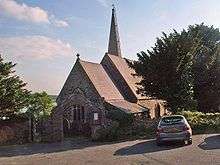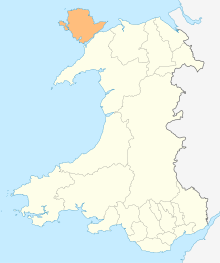Llanfairpwllgwyngyll
Llanfairpwllgwyngyll or Llanfair Pwllgwyngyll (pronounced [ɬanˌvair puɬˈɡwɨ̞nɡɨ̞ɬ]) is a large village and local government community on the island of Anglesey in Wales. It is situated on the Menai Strait next to the Britannia Bridge and across the strait from Bangor. Both shortened (Llanfairpwll or Llanfair PG) and lengthened (Llanfairpwllgwyngyllgogerychwyrndrobwllllantysiliogogogoch) forms of the placename are used in various contexts (with the longer form pronounced [ˌɬanvair![]()
| Llanfairpwllgwyngyll | |
|---|---|
_-_geograph.org.uk_-_1058331.jpg) | |
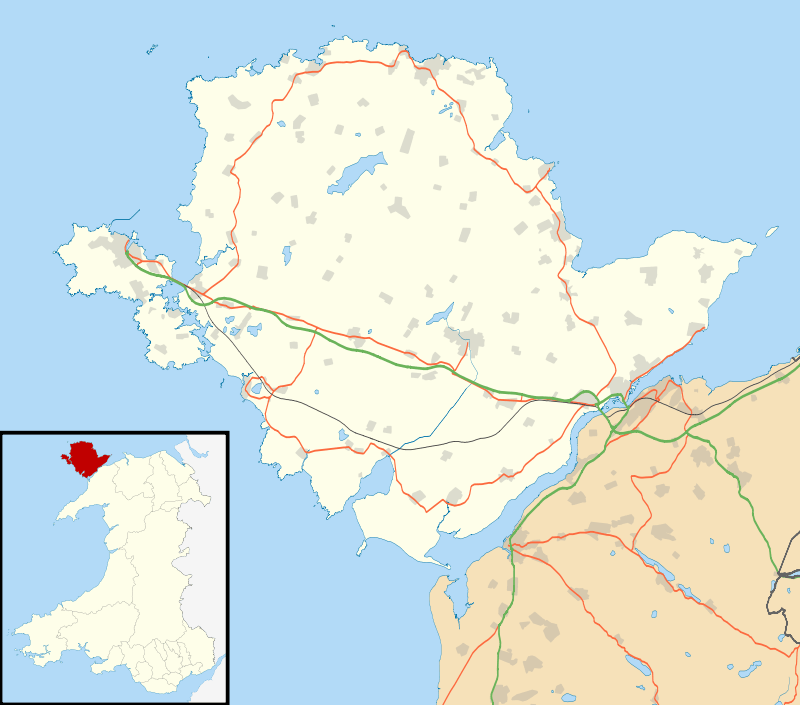 Llanfairpwllgwyngyll Location within Anglesey | |
| Population | 2,999 (2018 Estimate)[1] |
| OS grid reference | SH528716 |
| Community | |
| Principal area |
|
| Ceremonial county | |
| Country | Wales |
| Sovereign state | United Kingdom |
| Post town | LLANFAIRPWLLGWYNGYLL |
| Postcode district | LL61 |
| Dialling code | 01248 |
| Police | North Wales |
| Fire | North Wales |
| Ambulance | Welsh |
| UK Parliament | |
| Senedd Cymru – Welsh Parliament |
|
At the 2001 census, the population of the community was 3,040.[4] By the time of the 2011 Census the population had increased to 3,107,[5] of whom 71% could speak Welsh.[6] It is the sixth largest settlement on the island by population.
The long form of the name, with 58 characters split into 19 syllables, is the longest place name in Europe and the second longest official one-word place name in the world.[7] Although this name is generally stated to have been invented in the 1860s for promotional purposes, a similarly lengthy version was recorded as early as 1849.[8]
History
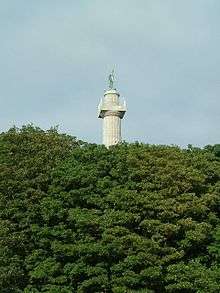
There has been human activity and settlement in the area of the village since the Neolithic era (4000–2000 BC), with subsistence agriculture and fishing the most common occupations for much of its early history. The island of Anglesey was at that point reachable only by boat across the Menai Strait. A largely destroyed, collapsed dolmen can be found from this period in the parish, located at Ty Mawr north of the present-day church; early Ordnance Survey maps show a long cairn on the site.[9] The probable remains of a hillfort, with a fragmentary bank and ditch, were recorded on an outcrop known as Craig y Ddinas.[10]
The area was briefly invaded and captured by the Romans under Gaius Suetonius Paulinus, temporarily abandoned in order to consolidate forces against Boudicca, then held until the end of Roman Britain.
With the withdrawal of the Roman forces, the area fell under the control of the early medieval Kingdom of Gwynedd. There has probably been a small Christian religious site, perhaps a monastic cell, here since the 7th century.[11] Surveys of the later medieval period show that the tenants of the township of Pwllgwyngyll, as it was then known, held a total of 9 bovates of land from the Bishop of Bangor under the feudal system.[12] A church was built during the medieval period and dedicated to Mary, probably under Norman influence: the building, later demolished and replaced by a Victorian-era church, was unusual in having a semi-circular apse, a feature more usually associated with cathedrals.[13] Despite religious activity, the rural nature of the settlement meant that the parish had a population of only around 80 in 1563.
Much of the land was absorbed into the Earldom of Uxbridge, which later became the Marquisate of Anglesey, and was subject to enclosures. In 1844, for example, 92% of the land in Llanfairpwll was owned by just three individuals. The population of the parish reached 385 by 1801.
In 1826, Anglesey was connected to the rest of Wales by the construction of the Menai Suspension Bridge by Thomas Telford, and connected with London in 1850 with the building of the Britannia Bridge and the busy North Wales Coast railway line, which connected the rest of Great Britain to the ferry port of Holyhead. The old village, known as Pentre Uchaf ("upper village") was joined by new development around the railway station, which became known as Pentre Isaf, the "lower village".
The first meeting of the Women's Institute took place in Llanfairpwll in 1915, and the movement (which began in Canada) then spread through the rest of the British Isles.[14]
Placename and toponymy
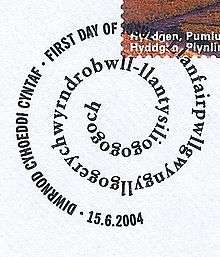
The long form of the name is the longest place name in the United Kingdom and one of the longest in the world at 58 characters (51 "letters" since "ch" and "ll" are digraphs, and are treated as single letters in the Welsh language).
Literally translated, the name means: [The] church of [St.] Mary (Llanfair) [of the] pool (pwll)[15] of the white hazels (gwyn gyll) near [lit. "over against"] (go ger) the rapid whirlpool (y chwyrn drobwll) [and] the church of [St.] Tysilio (Llantysilio) of the red cave (-ogo[f] goch). Various elements have occasionally been translated differently, for example "the white pool among the hazel trees"[16] or "the cave of St Tysilio the Red".[17]
Pwllgwyngyll, "the pool of the white hazels",[18] was the original name of the medieval township within whose boundaries the present-day village lies.[19] Pwllgwyngyll was one of two townships making up the parish, the other being Treforion; its name was first recorded as Piwllgunyl in an ecclesiastical valuation conducted in the 1250s for the Bishop of Norwich.[20] The parish name was recorded as Llanfair y Pwllgwyngyll (y = "(of) the") as far back as the mid 16th century, in Leland's Itinerary: the suffixing of the township name to that of the church would have served to distinguish the parish from the many other sites dedicated to Mary in Wales.
Longer versions of the name are thought to have first been used in the 19th century in an attempt to develop the village as a commercial and tourist centre (see below). The village is, however, still signposted Llanfairpwllgwyngyll, marked on Ordnance Survey maps as Llanfair Pwllgwyngyll and the railway station is officially named Llanfairpwll, a form used by local residents. The name is also shortened to Llanfair PG, sufficient to distinguish it from other places in Wales called Llanfair.
19th century renaming
.jpg)
The long name was supposedly contrived in 1869 as an early publicity stunt to give the station the longest name of any railway station in Britain.[21] According to Sir John Morris-Jones the name was created by a local tailor, whose name he did not confide, letting the secret die with him.[22][23] This form of the name adds a reference to the whirlpool in the Menai Strait known as the Swellies and to the small chapel of St. Tysilio, located on a nearby island.[24] The final -gogogoch ("red cave") is supposed to have been an addition inspired by the Cardiganshire parish of Llandysiliogogo, rather than by any local features.[25]
The true originator and date of the longer version of the name is less certain, however: an ecclesiastical directory published several years before the claimed renaming gives what it calls the "full" parish name in the slightly differing form of Llanfairpwllgwyngyllgogerbwlltysiliogogo ("St Mary's church of the pool of the white hazels over against the pool of St Tysilio Gogo [Tysilio of the cave]"),[18] while Llan-vair-pwll-gwyn-gyll-goger-bwll-dysilio-gogo appears in a paper on placenames published in 1849, its author noting that "the name was generally abridged" by locals.[8] While the addition regarding the Swellies is supposed only to have been made in the 1860s, early 19th century guidebooks had already suggested a derivation of the element pwllgwyngyll from pwll, gwyn and gwyll ("gloomy raging pool"), in reference to the Swellies.[26]
Pronunciation
The ⟨ch⟩ is a voiceless uvular fricative [χ] or voiceless velar fricative as in Bach ([bax]: see ach-Laut) in most varieties of German. The ⟨ll⟩ is a voiceless lateral fricative [ɬ], a sound that does not occur in English.
Tourism and attractions
A few thousand local residents welcome about 200,000 visitors per year.[27] The most popular attraction is the Llanfairpwll railway station that features the plate with the full name of the village. Other places of interest in the area include Anglesey Sea Zoo, Bryn Celli Ddu Burial Chamber, St Tysilio's Church, Menai Bridge, and Plas Cadnant Hidden Gardens.[28]
In popular culture
The name was submitted to Guinness World Records as the longest word to appear in a published cryptic crossword, having been used by compiler Roger Squires in 1979. The clue was "Giggling troll follows Clancy, Larry, Billy and Peggy who howl, wrongly disturbing a place in Wales (58)", where all but the last five words formed an anagram.[29]
In his appearance on You Bet Your Life, John Hughes answered host Groucho Marx's question about the location of his birth place by mentioning the town.
In the Stephen Sondheim-penned song "The Boy From...", the singer details her unrequited love for a boy from the (fictional) island of Tacarembo la Tumbe del Fuego Santa Malipas Zatatecas la Junta del Sol y Cruz, who is moving to Llanfairpwllgwyngyllgogerychwyrndrobwllllantysiliogogogoch.[30] Part of the song's humor stems from the singer's attempts to catch her breath after repeatedly singing the unwieldy place names.
In 1995, Welsh band Super Furry Animals released its debut EP, Llanfairpwllgwyngyllgogerychwyrndrobwllantysiliogogogochynygofod (In Space).[31]
The computer game Civilization V awards the "Longest. Name. Ever." Steam achievement to players for having a city named Llanfairpwllgwyngyll.[32]
In the 1968 movie Barbarella, Dildano proposes that the password for a meeting is "Llanfairpwllgwyngyllgogerychwyrndrobwllllantysiliogogogoch".
Climate
Llanfairpwllgwyngyllgogerychwyrndrobwllllantysiliogogogoch has a temperate oceanic climate (Köppen Cfb; Trewartha Do), with mild summers and cool, wet winters.
| Climate data for Llanfairpwllgwyngyll, 1961–1990, Altitude: 15 metres above mean sea level | |||||||||||||
|---|---|---|---|---|---|---|---|---|---|---|---|---|---|
| Month | Jan | Feb | Mar | Apr | May | Jun | Jul | Aug | Sep | Oct | Nov | Dec | Year |
| Record high °C (°F) | 16 (61) |
17 (63) |
22 (72) |
24 (75) |
28 (82) |
29 (84) |
31 (88) |
34 (93) |
27 (81) |
25 (77) |
18 (64) |
17 (63) |
34 (93) |
| Average high °C (°F) | 7.7 (45.9) |
8.0 (46.4) |
9.7 (49.5) |
12.1 (53.8) |
15.2 (59.4) |
17.9 (64.2) |
19.4 (66.9) |
19.3 (66.7) |
17.4 (63.3) |
14.6 (58.3) |
10.5 (50.9) |
8.7 (47.7) |
13.4 (56.1) |
| Daily mean °C (°F) | 5.2 (41.4) |
5.1 (41.2) |
6.6 (43.9) |
8.5 (47.3) |
11.3 (52.3) |
14.0 (57.2) |
15.7 (60.3) |
15.6 (60.1) |
13.9 (57.0) |
11.5 (52.7) |
7.8 (46.0) |
6.1 (43.0) |
10.1 (50.2) |
| Average low °C (°F) | 2.6 (36.7) |
2.2 (36.0) |
3.4 (38.1) |
4.9 (40.8) |
7.4 (45.3) |
10.1 (50.2) |
11.9 (53.4) |
11.9 (53.4) |
10.4 (50.7) |
8.3 (46.9) |
5.0 (41.0) |
3.5 (38.3) |
6.8 (44.2) |
| Record low °C (°F) | −9 (16) |
−8 (18) |
−7 (19) |
−3 (27) |
−1 (30) |
2 (36) |
5 (41) |
4 (39) |
1 (34) |
−1 (30) |
−4 (25) |
−8 (18) |
−9 (16) |
| Average rainfall mm (inches) | 107 (4.2) |
72 (2.8) |
85 (3.3) |
65 (2.6) |
65 (2.6) |
68 (2.7) |
74 (2.9) |
95 (3.7) |
98 (3.9) |
120 (4.7) |
130 (5.1) |
123 (4.8) |
1,102 (43.3) |
| Average rainy days (≥ 0.2 mm) | 19.7 | 15.0 | 18.9 | 14.1 | 18.9 | 13.7 | 13.1 | 15.1 | 15.8 | 18.7 | 19.5 | 19.5 | 202 |
| Average snowy days | 2.9 | 3.1 | 1.7 | 0.7 | 0.1 | 0.0 | 0.0 | 0.0 | 0.0 | 0.0 | 0.4 | 1.6 | 10.5 |
| Mean monthly sunshine hours | 49.6 | 73.5 | 105.4 | 153.0 | 195.3 | 183.0 | 173.6 | 164.3 | 126.0 | 93.0 | 57.0 | 40.3 | 1,414 |
| Source: Met Office[33] | |||||||||||||
| Climate data for Llanfairpwllgwyngyll, 1961–1990, Altitude: 15 metres above mean sea level | |||||||||||||
|---|---|---|---|---|---|---|---|---|---|---|---|---|---|
| Month | Jan | Feb | Mar | Apr | May | Jun | Jul | Aug | Sep | Oct | Nov | Dec | Year |
| Average rainy days (≥ 1.0 mm) | 15.6 | 11.2 | 13.0 | 10.4 | 10.9 | 10.3 | 9.4 | 11.7 | 12.3 | 15.0 | 15.7 | 15.1 | 150.6 |
| Source: Met Office[33] | |||||||||||||
| Climate data for Llanfairpwllgwyngyll, 1961–1990, Altitude: 15 metres above mean sea level | |||||||||||||
|---|---|---|---|---|---|---|---|---|---|---|---|---|---|
| Month | Jan | Feb | Mar | Apr | May | Jun | Jul | Aug | Sep | Oct | Nov | Dec | Year |
| Average rainy days (≥ 10.0 mm) | 2.5 | 1.7 | 2.0 | 1.5 | 1.2 | 1.6 | 2.2 | 2.7 | 2.8 | 3.4 | 3.8 | 3.5 | 28.9 |
| Source: Met Office[33] | |||||||||||||
Notable people
- Wilfred Mitford Davies (1895–1966) Welsh artist and publisher, went to school in the town.
- Sir John "Kyffin" Williams, KBE, RA (1918–2006) Welsh landscape painter, lived at Pwllfanogl, Llanfairpwll.
- John Lasarus Williams (1924–2004), known as John L, was a Welsh nationalist activist.
- Naomi Watts (born 1968), English actress and film producer, lived in the town as a child.
- Taron Egerton (born 1989), Welsh actor, went to school in the town.
- Siobhan Owen (born 1993), soprano and harpist from Llanfairpwll who now lives in Adelaide, emigrated aged two.
See also
- Llanfairpwll F.C., the village's football club
- List of long place names
References
- "Llanfairpwllgwyngyll". 26 October 2019. Retrieved 10 August 2020.
Population Estimate 2018-06-30
- "Llanfairpwllgwyngyll Community Council Members". Llanfairpwll.org. Archived from the original on 7 February 2019.
- "Llanfair Pwllgwyngyll". Ordnance Survey.
- "Area: Llanfair Pwllgwyngyll Community". Neighbourhood Statistics. Archived from the original on 6 December 2007. Retrieved 2 February 2020.
- "Llanfairpwllgwyngyll in Isle of Anglesey (Wales / Cymru)". CityPopulation.de. Retrieved 10 April 2019.
- "Community population and percentage of Welsh speakers". Neighbourhood Statistics. Retrieved 18 May 2015.
- Hoeller, Sophie-Claire (12 September 2015). "Here's the story behind the 58-letter town name in Wales that everyone is talking about". Business Insider. Retrieved 18 September 2016.
- Hume, Rev. A. (1849). "Philosophy of Geographical Names". Proceedings of the Literary and Philosophical Society of Liverpool (6): 44. Retrieved 25 February 2020.
- An Inventory of the Ancient Monuments in Anglesey, Volume 2. Aberystwyth: Royal Commission on the Ancient and Historical Monuments of Wales. 1960 [1937]. p. 73.
- An Inventory of the Ancient Monuments in Anglesey, Volume 2. Aberystwyth: Royal Commission on the Ancient and Historical Monuments of Wales. 1960 [1937]. p. 74.
- Jones, Geraint I. L. (2006). "History of St Mary's Llanfairpwll". The Church in Wales. Retrieved 25 February 2020.
- Longley, David. Medieval settlement on Anglesey: an assessment of the potential for fieldwork. Bangor, Gwynedd: Gwynedd Archaeological Trust.
- "St Mary's Church, Llanfairpwll". History Points. Retrieved 23 November 2018.
- "Llanfairpwll - History of the village". Llanfairpwllgwyngyllgogerychwyrndrobwllllantysiliogogogoch.co.uk. Retrieved 16 May 2018.
- Davies, Ellis (1959). Flintshire Place-names. Cardiff: University of Wales Press. p. 141. pwll - "pool, pond, pit"
- Edwards (ed), J. Hugh (1912). Wales: a national magazine. II (1). Missing or empty
|title=(help)CS1 maint: extra text: authors list (link) - Pryce, Thomas (1900). "History of the Parish of Llandysilio". Collections Historical & Archaeological relating to Montgomeryshire. XXXI (12).
- Davies, James (1866). Bangor diocesan directory, for the year 1866. Tremadoc: R. I. Jones. p. 8.
- Richards, Grafton Melville (1972). "Place Names". An Atlas of Anglesey. Llangefni: Anglesey Community Council.
- Lunt, William E., ed. (1926). The Valuation of Norwich. Oxford: Clarendon Press. p. 788.
- Davies, John; Jenkins, Nigel; Baines, Menna, eds. (2008). The Welsh Academy Encyclopedia of Wales. Cardiff: University of Wales Press. p. 487. ISBN 978-0-70831-953-6.
- Barnes, David (21 March 2005). The Companion Guide to Wales. Companion Guides. ISBN 978-1-90063-943-9 – via Google Books.
- Byrne, Eugene (22 July 2011). "Pronounced how?". History Extra. Archived from the original on 21 March 2019.
- McDonald, Fred; Cresswell, Julia (1993). The Guinness Book of British Place Names. Enfield, Middlesex: Guinness Publications. p. 100. ISBN 978-0-85112-576-3.
- Owen, Hywel Wyn (2015). The Place-Names of Wales (Revised and expanded ed.). Cardiff: University of Wales Press. p. 63. ISBN 978-1-78316-164-5.
- Nicholson, George (1813). The Cambrian Traveller's Guide. London: Longman, Hurst, Rees, Orme & Brown. p. 75.
- "Llanfairpwllgwyngyll". Rove.me. Retrieved 10 April 2019.
- "Things to Do in Llanfairpwllgwyngyll". TripAdvisor. Retrieved 10 April 2019.
- "Blog Archive » Guardian 25,102 / Rufus". Fifteensquared.net. 30 August 2010. Retrieved 28 May 2013.
- Suskin, Steven. Showtunes: the Songs, Shows, and Careers of Broadway's Major Composers (4th Revised and expanded ed.). p. 266. ISBN 0-19-531407-7.
- "Llanfairpwllgwyngyllgogerychwyrndrobwllantysiliogogogochynygofod (In Space) E.P." 45cat. Retrieved 14 October 2019.
- "Sid Meier's Civilization V: Global Achievements". Steam. Retrieved 25 February 2020.
- "Example climate estimate". Met Office. Archived from the original on 5 September 2015.
External links
- Official website Listed in the 2002 Guinness Book of Records as the world's longest valid Internet domain name
- Llanfairpwllgwyngyll at Curlie
- Ball, John. "Origins and meaning of Llanfairpwllgwyngyllgogerychwyrndrobwllllantysiliogogogoch". Sounds of Wales.
- "All Photos Tagged llanfairpwllgwyngyllgogerychwyrndrobwllllantysiliogogogoch". Flickr.
- "Photos of Llanfair PG and surrounding area". Geograph.

